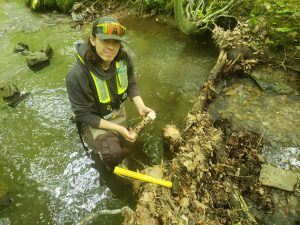0.4 Decimals
Applications
Most environmental data that we work with is continuous, that is - data do not need to represent whole numbers. Think about water temperature. Your temperature could read any value between 0 and 100 (freezing to boiling). The thermometer might read 46º C 46.3º C, or 12.74º C . Because most environmental data is continuous, we need to be comfortable working with data in decimal formats.

Decimal notation is based on powers of [latex]10[/latex]: [latex]0.1[/latex] is one tenth, [latex]0.01[/latex] is one hundredth, [latex]0.001[/latex] is one thousandth, and so on.
| thousands | hundreds | tens | ones/units | . | tenths | hundredths | thousandths |
Practice Exercises
Write each number.
- ninety and twenty-three hundredths
- seven and fifty-six thousandths
Adding & Subtracting Decimals
Before you add or subtract decimals, you must line up the decimal points.
Practice Exercises
Add each pair of numbers.
- [latex]3.75+12.8[/latex]
- [latex]71.085+112.93[/latex]
When subtracting, you may need to add zeros to the first number so you can borrow correctly.
Practice Exercises
Subtract each pair of numbers.
- [latex]46.57–38.29[/latex]
- [latex]82.78–67.024[/latex]
Multiplying Decimals
To multiply decimal numbers:
- Temporarily ignore the decimal points.
- Multiply the numbers as though they are whole numbers.
- Add the total number of decimal digits in the two numbers you multiplied. The result will have that number of digits to the right of the decimal point.
Note: You do NOT need to line up the decimal points when you are multiplying.
Practice Exercises
Multiply each pair of numbers.
- [latex]143\cdot29[/latex]
- [latex]143\cdot2.9[/latex]
- [latex]14.3\cdot2.9[/latex]
- [latex]1.43\cdot2.9[/latex]
- [latex]375\cdot175[/latex]
- [latex]375\cdot0.175[/latex]
- [latex]3.75\cdot1.75[/latex]
- Evie worked [latex]37.5[/latex] hours at a pay rate of [latex]$17.50[/latex] per hour. How much did she earn in total?
Dividing Decimals
Let's review everyone's favorite topic, long division. The three parts of a division are named as follows: dividend [latex]\div[/latex] divisor = quotient. When this is written with a long division symbol, the dividend is inside the symbol, the divisor is on the left, and the quotient is the answer we create on top.

To divide by a decimal:
- Write in long division form.
- Move the decimal point of the divisor until it is a whole number.
- Move the decimal point of the dividend the same number of places to the right.
- Place the decimal point in the quotient directly above the decimal point in the dividend.
- Divide the numbers as though they are whole numbers.
- If necessary, add zeros to the right of the last digit of the dividend to continue.
Practice Exercises
- [latex]974\div4[/latex]
- [latex]974\div0.4[/latex]
- [latex]9,740\div0.04[/latex]
- [latex]0.0974\div0.004[/latex]
Rounding Numbers
It is often necessary to round a number to a specified place value. We will see more specific instructions in Chapter 0.5 but let's review the basics of rounding a number.
Rounding a number:
- Locate the rounding digit in the place to which you are rounding.
- Look at the test digit directly to the right of the rounding digit.
- If the test digit is 5 or greater, increase the rounding digit by 1 and drop all digits to its right.
- If the test digit is less than 5, keep the rounding digit the same and drop all digits to its right.
Practice Exercises
Round each number to the indicated place value.
- [latex]6,375[/latex] (thousands)
- [latex]6,375[/latex] (tens)
- [latex]0.7149[/latex] (hundredths)
- [latex]0.7149[/latex] (thousandths)
If a decimal answer goes on and on, it may be practical to round it off.
Practice Exercises
- A subscription to The Chicago Manual of Style Online costs [latex]$44.00[/latex]. Determine the monthly cost, rounded to the nearest cent.
- In the summer of 1919, a military convoy (including Lt. Col. Dwight Eisenhower) drove from Washington, D.C. to San Francisco to assess the condition of the nation's developing highway system. The journal entry for August 1 says "Good dirt roads. Made 82 miles in 11 hrs."[1] What was the convoy's effective speed in miles per hour for that day? Round your result to the nearest tenth.
- Source: https://after-ike.com/logbook-1919-transcontinental-military-convoy/. See https://www.nytimes.com/2019/07/07/opinion/the-most-important-road-trip-in-american-history.html if you're interested in the historical context. ↵

